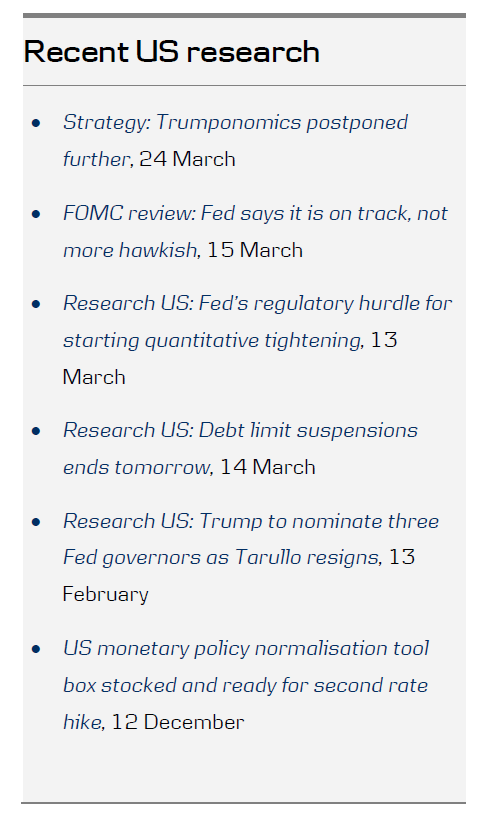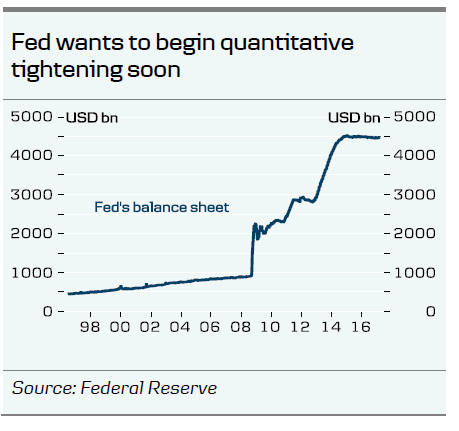In terms of the economic development there was not much new in the FOMC minutes, as the FOMC members have already been quite outspoken since the meeting. The overall message from the meeting was that the Fed is on track and delivered one of the three hikes it projected back in December 2016 – the Fed has not become more hawkish, see FOMC Review: Fed says it is on track, not more hawkish, 15 March. The Fed signalled a total of three Fed hikes both this year and next year, more or less in line with our expectations. We expect the Fed to hike in July and December and 3-4 times next year.
However, as Yellen had hinted at, the FOMC participants discussed when to change their current reinvestment strategy (which states that the Fed will continue to reinvest principal payments until the normalisation of the Fed funds rate is ‘well under way’). The minutes say that ‘a change to the Committee’s reinvestment policy would likely be appropriate later this year’. We still expect the Fed to begin shrinking its balance sheet in Q1 18 (what we call quantitative tightening), while consensus among both primary dealers and analysts is mid-2018, but risk is skewed towards already by the end of this year (perhaps December). We think an announcement on what could trigger quantitative tightening is likely in connection with the June meeting. The FOMC members still want quantitative tightening to be ‘conducted in a passive and predictable manner’.
We have written intensively on quantitative tightening recently. Rising demand for currency, change in US treasury cash balance policy and financial regulation limit the scope for a reduction of the balance sheet. The risk is that quantitative tightening could lead to an unwarranted tightening of USD liquidity. For more see also Research US: Fed’s regulatory hurdle for starting quantitative tightening, 13 March.
The participants also discussed whether the timing of quantitative tightening should be based on a quantitative threshold or on a qualitative judgement. Based on the minutes, ‘several’ participants prefer the former while ‘some’ prefer the latter, meaning that quantitative tightening would likely depend on the Fed funds target range or the level of an economic variable (possibly the PCE inflation rate or the unemployment rate, as was the case with the Evans rule).
The minutes indicate that the FOMC members ‘generally preferred to phase out or cease reinvestments of both Treasury securities and agency MBS’. This is slightly new, as the Fed has previously indicated it preferred to reduce its holding of MBS. The FOMC members also discussed pros and cons about whether to phase out or cease reinvestments all at once without being specific about what they prefer.
Also interesting, the Fed staff still expects the Trump administration to ease fiscal policy but has ‘pushed back the timing of when those policy changes were anticipated to take effect’. We have also become more pessimistic on the outlook for Trumponomics after the Republicans’ failure to change Obamacare. Changes to US economic policy are likely to come later and be smaller than previously expected due to the uncertainty within the Republican Party. For more details see also Strategy: Trumponomics postponed further, 24 March.
















